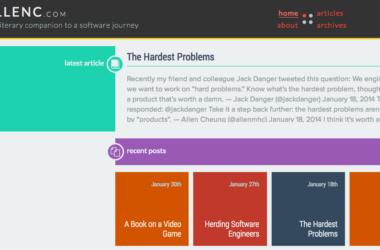Hey, it’s a fresh coat of paint!
Every couple of years, I get tired of looking at how this blog looks, and that prompts me to look to refresh the look and feel of the site. The last time I did this was about 3 years ago, when I updated a customized version of the Typology WordPress theme—I’ve been running the CMS for the past decade once I got tired of building my own blogging engine1—to a customized version of the Alia WordPress theme. This time, I went with a theme called Caards, which as the name suggests, is thematically centered around cards.
WordPress started its life as a giant pile of barely-organized PHP code, and sometime in 2018, it stacked an additional giant pile of JavaScript on top with its release of its Gutenberg editor. It used to take me 4–6 months to author a WordPress theme, either from scratch or off of an existing template, but nowadays I can’t be bothered to spend more than a week or two tweaking parameters to get most of what I want out of the design. Sure, much of this can be ascribed to simple laziness, but in the year 2024:
- Custom themes have had 2 decades to mature. For a simple use case like blogging, there is little left to do2; the minimalist trends of the last few years have only pushed designs simpler. From a development standpoint, it feels like the industry has been pushing more toward adding admin and editing functionality instead, investing in no-code frameworks to enable users to configure their way to personalized designs.
- There are now so many combinations of devices, screen sizes and resolutions, light and dark modes, variations in layout, etc. all of which are hard to build for. Yes, responsive frameworks solve some of the multiplexing, but fully testing all the variations is a huge pain, and I’ve broken enough layouts to know that it’s preferable to let a dev shop set reasonable defaults instead.
- The above complexity and maturation have meant that the aforementioned piles of PHP and JavaScript are now compartmentalized piles of code. Ironically, it means that modifications are more difficult, or at least more fragile; finding the right place to insert a custom widget or add a component requires digging into system hooks and injecting hacky HTML & PHP, much of which would be overwritten in a version update. It also takes way too much effort to make these code-level tweaks; these modules weren’t written for users to read and extend.
But above all of the technical complexities and development difficulties, the harsh reality is that in today’s web, there’s also less value in customizing websites. Google’s crawlers will index it regardless, and the company has announced it’ll double down on its Search Generative Experience and summarize results instead of just linking out to them. They’re only catching up to what other AI companies have already done—make use of widely available content as LLM training data, and prioritize generated results stripped of its underlying styling and design context.
In the long run, I suspect this will have the gradual effect of hollowing out the middle, mimicking the impact of so many other technologies. Mutual AI escalation will make it much easier to generate generic blogs and content on the bottom end, but it will take real talent and effort to make bespoke experiences that cannot be easily aggregated and churned through machine-learning models. Till we get there, though—I might as well spiff up the room here a bit.


